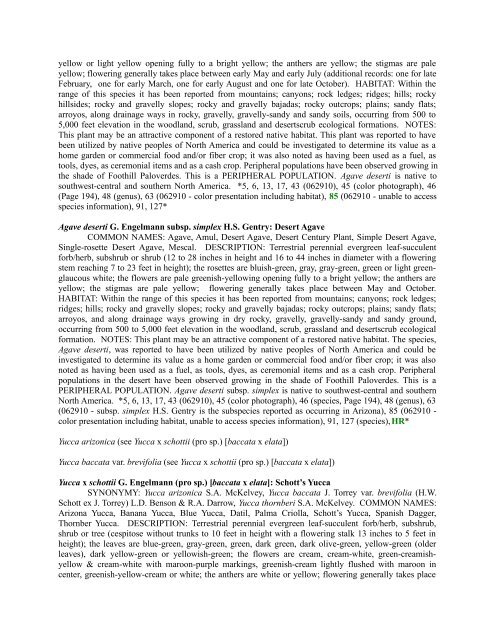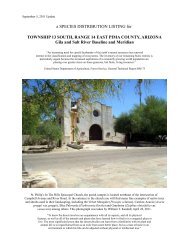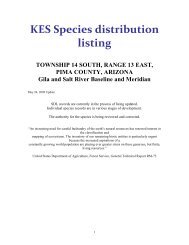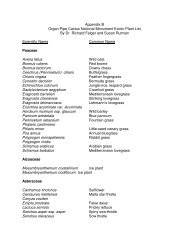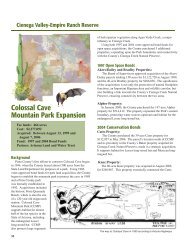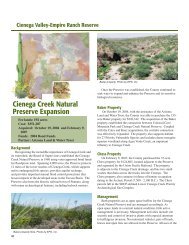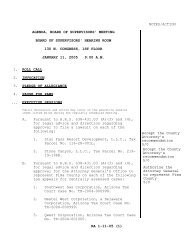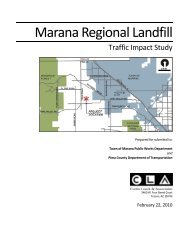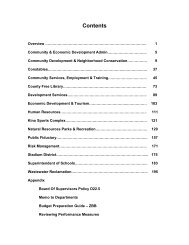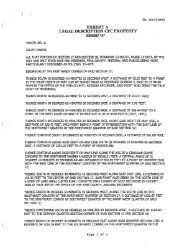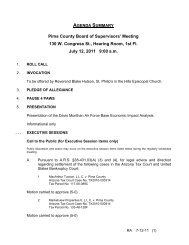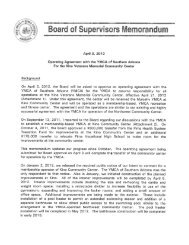Le Jardin de Mère Nature dans une Petite Planète - Pima County
Le Jardin de Mère Nature dans une Petite Planète - Pima County
Le Jardin de Mère Nature dans une Petite Planète - Pima County
Create successful ePaper yourself
Turn your PDF publications into a flip-book with our unique Google optimized e-Paper software.
yellow or light yellow opening fully to a bright yellow; the anthers are yellow; the stigmas are pale<br />
yellow; flowering generally takes place between early May and early July (additional records: one for late<br />
February, one for early March, one for early August and one for late October). HABITAT: Within the<br />
range of this species it has been reported from mountains; canyons; rock ledges; ridges; hills; rocky<br />
hillsi<strong>de</strong>s; rocky and gravelly slopes; rocky and gravelly bajadas; rocky outcrops; plains; sandy flats;<br />
arroyos, along drainage ways in rocky, gravelly, gravelly-sandy and sandy soils, occurring from 500 to<br />
5,000 feet elevation in the woodland, scrub, grassland and <strong>de</strong>sertscrub ecological formations. NOTES:<br />
This plant may be an attractive component of a restored native habitat. This plant was reported to have<br />
been utilized by native peoples of North America and could be investigated to <strong>de</strong>termine its value as a<br />
home gar<strong>de</strong>n or commercial food and/or fiber crop; it was also noted as having been used as a fuel, as<br />
tools, dyes, as ceremonial items and as a cash crop. Peripheral populations have been observed growing in<br />
the sha<strong>de</strong> of Foothill Palover<strong>de</strong>s. This is a PERIPHERAL POPULATION. Agave <strong>de</strong>serti is native to<br />
southwest-central and southern North America. *5, 6, 13, 17, 43 (062910), 45 (color photograph), 46<br />
(Page 194), 48 (genus), 63 (062910 - color presentation including habitat), 85 (062910 - unable to access<br />
species information), 91, 127*<br />
Agave <strong>de</strong>serti G. Engelmann subsp. simplex H.S. Gentry: Desert Agave<br />
COMMON NAMES: Agave, Amul, Desert Agave, Desert Century Plant, Simple Desert Agave,<br />
Single-rosette Desert Agave, Mescal. DESCRIPTION: Terrestrial perennial evergreen leaf-succulent<br />
forb/herb, subshrub or shrub (12 to 28 inches in height and 16 to 44 inches in diameter with a flowering<br />
stem reaching 7 to 23 feet in height); the rosettes are bluish-green, gray, gray-green, green or light greenglaucous<br />
white; the flowers are pale greenish-yellowing opening fully to a bright yellow; the anthers are<br />
yellow; the stigmas are pale yellow; flowering generally takes place between May and October.<br />
HABITAT: Within the range of this species it has been reported from mountains; canyons; rock ledges;<br />
ridges; hills; rocky and gravelly slopes; rocky and gravelly bajadas; rocky outcrops; plains; sandy flats;<br />
arroyos, and along drainage ways growing in dry rocky, gravelly, gravelly-sandy and sandy ground,<br />
occurring from 500 to 5,000 feet elevation in the woodland, scrub, grassland and <strong>de</strong>sertscrub ecological<br />
formation. NOTES: This plant may be an attractive component of a restored native habitat. The species,<br />
Agave <strong>de</strong>serti, was reported to have been utilized by native peoples of North America and could be<br />
investigated to <strong>de</strong>termine its value as a home gar<strong>de</strong>n or commercial food and/or fiber crop; it was also<br />
noted as having been used as a fuel, as tools, dyes, as ceremonial items and as a cash crop. Peripheral<br />
populations in the <strong>de</strong>sert have been observed growing in the sha<strong>de</strong> of Foothill Palover<strong>de</strong>s. This is a<br />
PERIPHERAL POPULATION. Agave <strong>de</strong>serti subsp. simplex is native to southwest-central and southern<br />
North America. *5, 6, 13, 17, 43 (062910), 45 (color photograph), 46 (species, Page 194), 48 (genus), 63<br />
(062910 - subsp. simplex H.S. Gentry is the subspecies reported as occurring in Arizona), 85 (062910 -<br />
color presentation including habitat, unable to access species information), 91, 127 (species), HR*<br />
Yucca arizonica (see Yucca x schottii (pro sp.) [baccata x elata])<br />
Yucca baccata var. brevifolia (see Yucca x schottii (pro sp.) [baccata x elata])<br />
Yucca x schottii G. Engelmann (pro sp.) [baccata x elata]: Schott’s Yucca<br />
SYNONYMY: Yucca arizonica S.A. McKelvey, Yucca baccata J. Torrey var. brevifolia (H.W.<br />
Schott ex J. Torrey) L.D. Benson & R.A. Darrow, Yucca thornberi S.A. McKelvey. COMMON NAMES:<br />
Arizona Yucca, Banana Yucca, Blue Yucca, Datil, Palma Criolla, Schott’s Yucca, Spanish Dagger,<br />
Thornber Yucca. DESCRIPTION: Terrestrial perennial evergreen leaf-succulent forb/herb, subshrub,<br />
shrub or tree (cespitose without trunks to 10 feet in height with a flowering stalk 13 inches to 5 feet in<br />
height); the leaves are blue-green, gray-green, green, dark green, dark olive-green, yellow-green (ol<strong>de</strong>r<br />
leaves), dark yellow-green or yellowish-green; the flowers are cream, cream-white, green-creamishyellow<br />
& cream-white with maroon-purple markings, greenish-cream lightly flushed with maroon in<br />
center, greenish-yellow-cream or white; the anthers are white or yellow; flowering generally takes place


